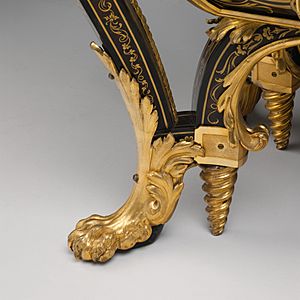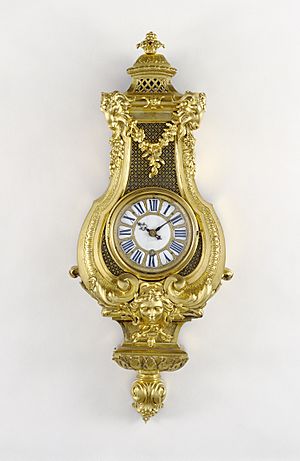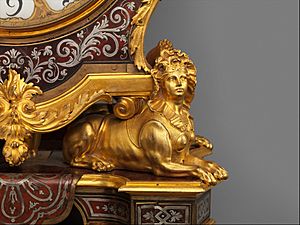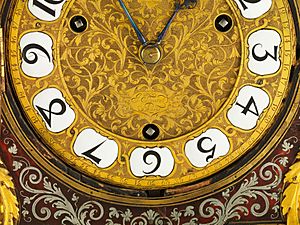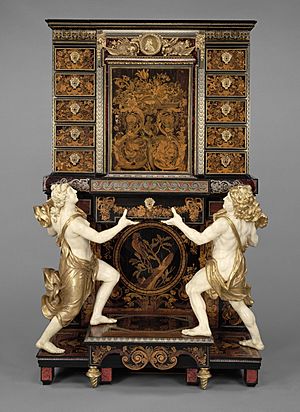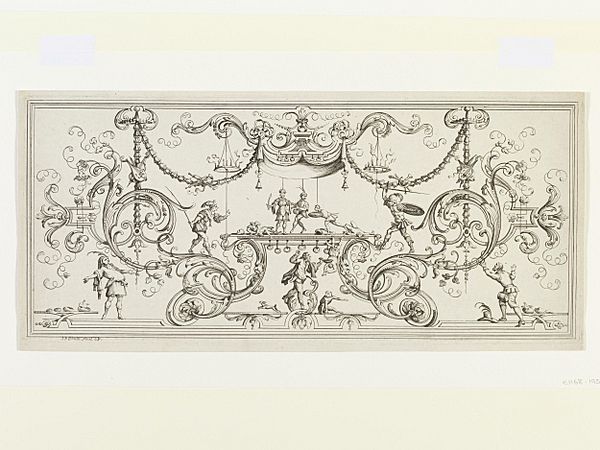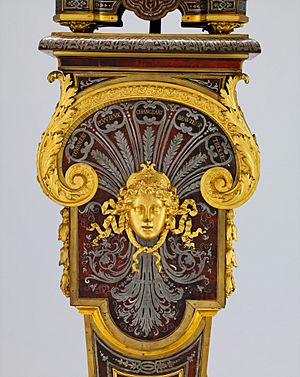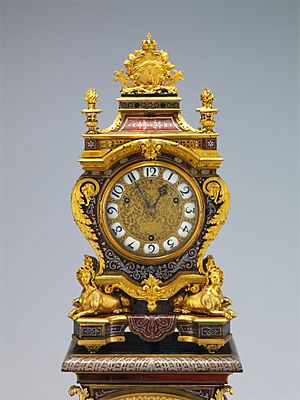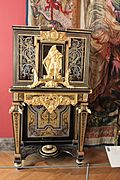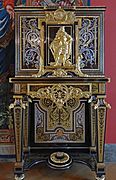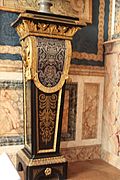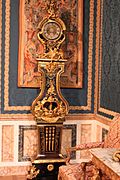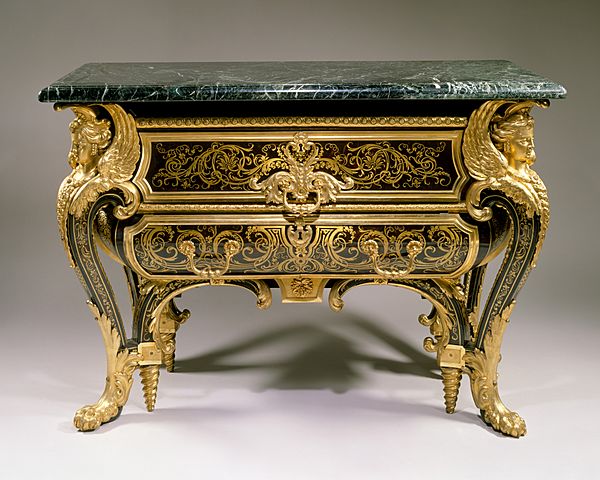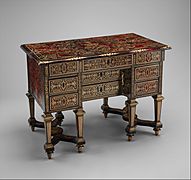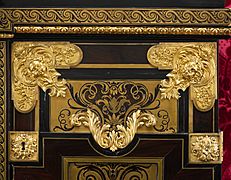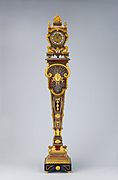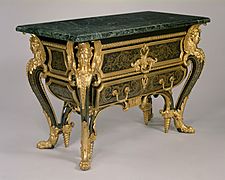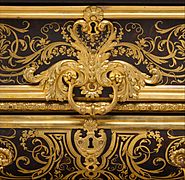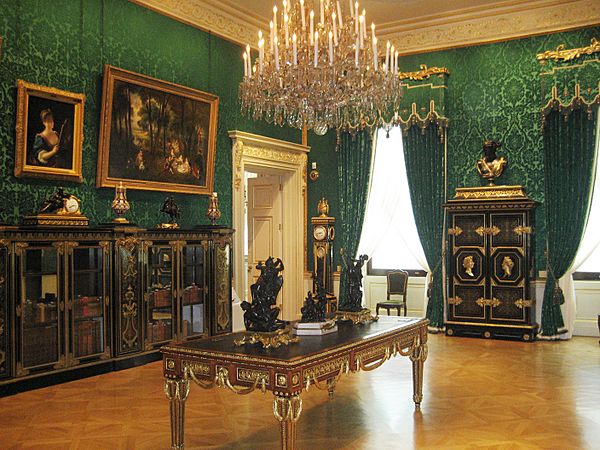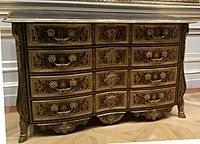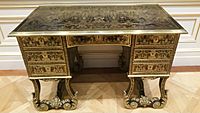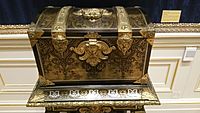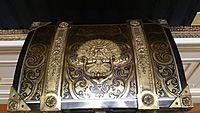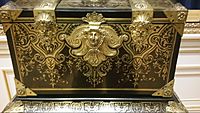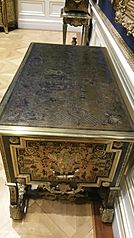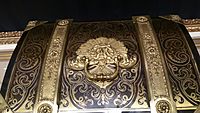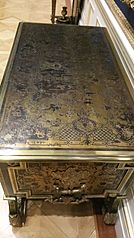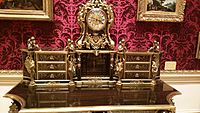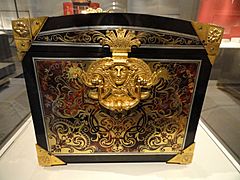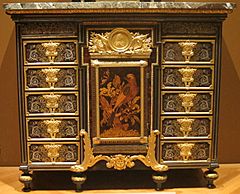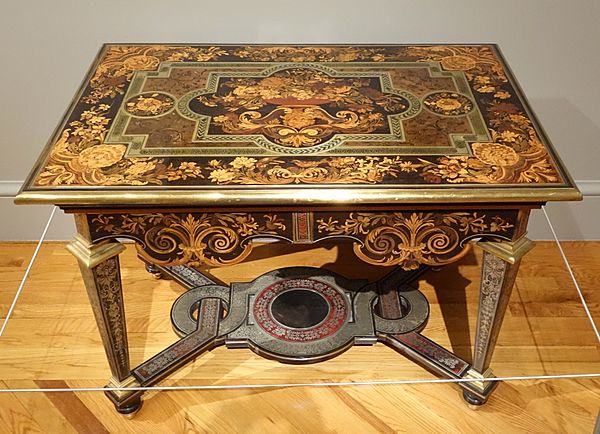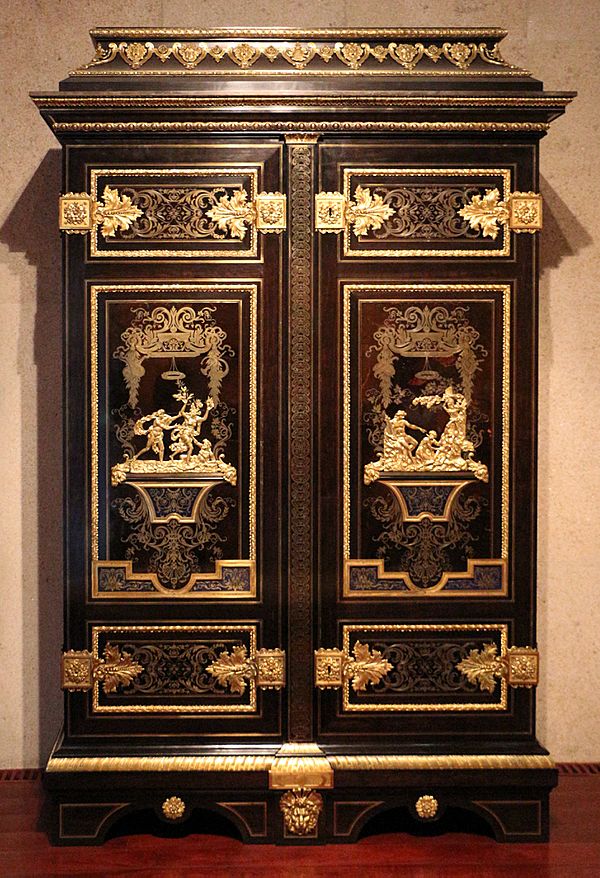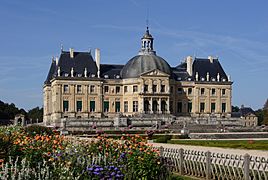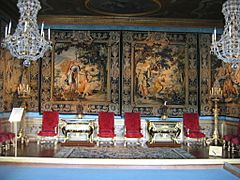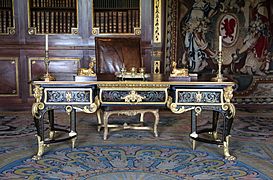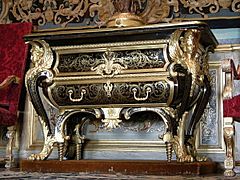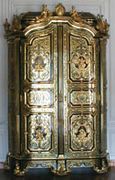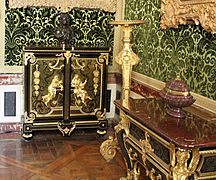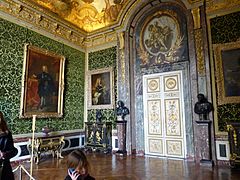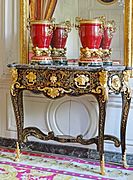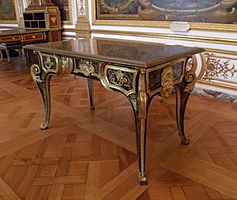André-Charles Boulle facts for kids
André-Charles Boulle (born November 11, 1642 – died February 29, 1732) was a very famous French cabinetmaker. He was known as "the furniture jeweller" because of his amazing skill. He was the best artist in a technique called marquetry, which is also known as "inlay". This means he decorated furniture by setting pieces of different materials into its surface.
Jean-Baptiste Colbert, a minister for Louis XIV of France, the "Sun King", said Boulle was "the most skilled craftsman in his profession". Over time, Boulle's name became linked to the special art he made perfect: inlaying tortoiseshell, brass, and pewter into ebony wood. This style is now called Boulle work. Today, a famous art school in Paris, the École Boulle (started in 1886), is named after him. This shows how important his art of inlay still is.
Life
André-Charles Boulle stated his birth date as November 11, 1642, on his marriage certificate in 1677. However, no other document confirms he was born in Paris on that date. Historians believe his father was Jan (or Jean) Bolt, who was Protestant. But at his own Catholic marriage, André-Charles Boulle said his father was "Jean Boulle."
Boulle's Catholic marriage and burial in 1732 don't quite match his possible Protestant background. This might be because Protestants were being treated badly at the time.
There are a few reasons why Boulle's family history is a bit of a mystery.
First, many foreign artists came to the Sun King's court and wanted to become French citizens. They would often change their names to fit in. For example, Jean-Baptiste Lully, the King's musician, changed his name from "Giovanni Battista Lulli." This makes it hard for historians to know which "Jean Boulle" or "Jean Bolt" was André-Charles Boulle's real father. Some of these names belong to French Catholics, some to French Protestants, and some to people from Holland.
Second, André-Charles Boulle's birth date is probably not exact. Even though he was a genius, he wasn't good at managing things or remembering dates. His children also got his age wrong when he died, saying he was 90, which is very unlikely.
Third, in October 1685, just eight years after Boulle's marriage, Louis XIV of France made Protestantism illegal. This was done through the Edict of Fontainebleau. All Protestant ministers had to leave the country or become Catholic. The King ordered Protestant churches and schools to be destroyed. This led to about 400,000 Protestants fleeing France.
Because of these times, it's likely that André-Charles Boulle "tidied up" his own birth date and place, as well as his father's name, to make sure they seemed Catholic. He might have made himself seem older for reasons we don't know. It's also possible he was born in Holland, which would explain some of the confusion about his family. We only have his word that he was born in Paris in 1642.
André-Charles Boulle grew up in an artistic family. His father, Jean Boulle, was a cabinetmaker for the King and lived in the Louvre palace. His grandfather, Pierre Boulle, was also a cabinetmaker for King Louis XIII and lived in the Louvre. So, André-Charles learned from two generations of famous artists, craftsmen, and engravers who worked directly for the King. His aunt, Marguerite Bahusche, was a famous painter, married to another well-known artist, Jacques Bunel de Blois.
We don't know much about Boulle's childhood or training. He likely learned his skills in his father's workshop at the Louvre. This was where he was closest to the Sun King and Jean-Baptiste Colbert, who discovered his talent.
By 1672, when he was 30, Boulle was given special living quarters in the Louvre palace. This was a great honor for artists who worked for the King. It also meant he didn't have to follow the strict rules of the trade guilds. Boulle received this special place because Jean-Baptiste Colbert called him "the most skilled ébéniste (cabinetmaker) in Paris." The King's order said Boulle was a chaser, gilder, and marquetry maker. He became the "Premier ébéniste du Roi" (First Cabinetmaker to the King).
Boulle originally wanted to be a painter, but his father made him learn other skills. This might explain why he loved collecting prints and paintings so much, even though it almost ruined him financially.
His first payment from the King in 1669 was for "painting works." Boulle worked for many years at the Versailles, where his mirrored walls, wood mosaic floors, and inlaid panels were considered his best work.
Boulle received many orders from the "Sun King" and other important people like foreign princes and French nobles. He was so famous that a saying about him became well-known: "Boulle y tourne en ovale" (Boulle turns it into an oval), meaning he could do anything.
Professor C.R. Williams wrote that during King Louis XIV's time, people paid huge amounts for beautiful furniture. Boulle was able to meet these demands with his imagination and skill. He was a remarkable man who understood that his furniture needed to be not only rich and beautiful but also comfortable and useful. He was appointed cabinetmaker to the Dauphin (the King's heir). He even started to act like his rich customers.
Boulle was like an aristocrat among furniture makers. He spent a lot of his money filling his workshop with art. His storage areas were full of expensive woods and amazing furniture pieces, both finished and unfinished. In his own rooms, he had priceless art, including drawings by Raphael and wax models by Michelangelo.
Boulle had three workshops and made many different items: commodes (chests of drawers), bureaux (desks), armoires (wardrobes), pedestals, clock cases, and lighting fixtures. These were often decorated with gilt-bronze (gold-plated bronze) that he designed himself. Even with his great skills and high prices, Boulle was always short on money. This was mainly because he loved collecting art so much. He often didn't pay his workers on time, and clients sometimes didn't get the furniture they ordered. People even tried to have him arrested for his debts, even though the King protected him. In 1704, the King gave him six months to sort out his money problems, saying it would be his last chance. It seems living beyond their means was a family habit, as one of his sons was later jailed for debt until King Louis XV released him.
In 1720, Boulle's money problems got worse when a fire destroyed one of his workshops. It burned 20 workbenches, tools, precious wood, and finished art. What was saved was sold, and he asked the Regent for financial help, but we don't know if he got it. His friend, Pierre-Jean Mariette, said Boulle's money troubles were because of his obsession with collecting art. The fire caused over 40,000 livres (French money) in losses, including old master paintings and drawings by Raphael.
Boulle went to almost every sale of drawings and engravings. He borrowed money at high interest rates to buy things. He died on February 29, 1732, in the Louvre, leaving many debts for his four sons to handle. He had given them ownership of his business and workshop 17 years earlier.
Family
Boulle had four sons: Jean-Philippe (1678-1744), Pierre-Benoît (c.1683-1741), André-Charles II (1685–1749), and Charles-Joseph (1688–1754). They took over his workshops and techniques in 1715. Even though all four sons were given the important title of "ébéniste du roi" (cabinetmaker to the king), they managed their money just as poorly as their father. Three of the four brothers died in debt.
Boulle work
Boulle used materials like tortoiseshell, brass, pewter, and even animal horn for his inlay. For the wood, he often chose dark, dense tropical woods like rosewood, ebony, and kingwood. His special marquetry technique involved cutting two contrasting sheets from a single "sandwich" of materials. If the sandwich had a light and a dark layer, he would get two finished pieces: one with a light pattern on a dark background, and the other with a dark pattern on a light background. The first was called première partie, and the second was called contrapartie. He would use both patterns, sometimes even on the same piece of furniture, or create matching pairs of contrasting cabinets.
Tortoiseshell

Tortoiseshell was cut into thin slices and inlaid onto wood. It's a key part of Boulle work. Even though it was rare and expensive, tortoiseshell was strong, felt warm, and had a beautiful mottled-red color. This made it perfect for dark woods like ebony, giving Boulle's work a sense of depth. To prepare it, the layers of the shell were separated by heating, then softened by boiling in salt water, and flattened. Pieces could be joined with a hot iron, and then polished.
Brass (Gilt bronze)
In 1608, King Henry IV created a special status for artists to encourage arts in France. This status freed them from strict guild rules and gave them other benefits. This was very important for André-Charles Boulle, who was given a prestigious workshop in 1672. In the same year, he was named "ébéniste, ciseleur, doreur du roi" (cabinetmaker, chaser, gilder to the King) by Marie-Thérèse d'Autriche, Louis XIV's wife. This workshop was more of a fancy address for Boulle, who also had his family workshop. He later got a much larger space in an old theater in the Louvre. Because he wasn't controlled by guilds, Boulle, who was also a sculptor, could create and cast his own gilt bronze (gold-plated bronze) decorations for his furniture. From 1685, he even had his own foundry (a place for casting metal), which was very important for his unique work. Boulle also made items purely from gilt-bronze, such as chandeliers, clocks, and wall lights, which added to his fame.
Pewter
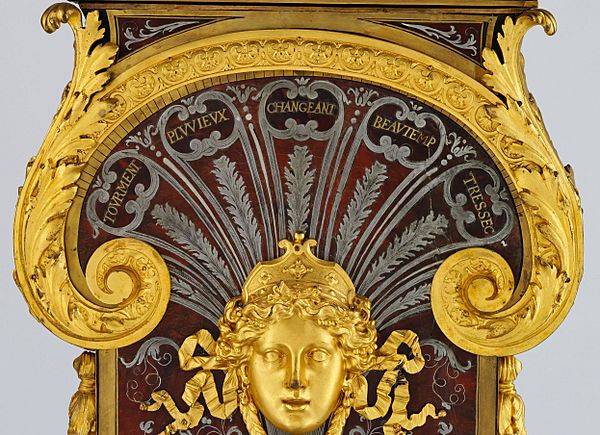
When pewter or brass was inlaid onto tortoiseshell, it was called premier-partie. When tortoiseshell was inlaid onto brass or pewter, it was called contre-partie. For an even richer look, Boulle would sometimes add mother-of-pearl, stained horn, and dyed tortoiseshell to his designs.
Works
André-Charles Boulle didn't keep good records of all the furniture he made. It's hard for experts to say for sure if a piece is truly from his workshop because his sons continued his style, and many others copied his work. Boulle didn't sign his pieces or use a special mark. Instead, he relied on the records kept by the Bâtiments du Roi (Royal Buildings department). These records didn't list new works with specific numbers or keep a daily log of what was made.
Only a few pieces can be definitely linked to his workshop through old documents. For example, a pair of commodes delivered to the King at the Grand Trianon in 1708 and 1709 are confirmed. Several large armoires (wardrobes) in the Louvre Museum and the Wallace Collection are also known to be from his workshop. Some of Boulle's works can be identified by the detailed marquetry, repeated design patterns, and his unique gilt-bronze mounts. We can also use images of his furniture designs published by his friend Pierre-Jean Mariette around 1720, workshop drawings, and descriptions from an inventory made in 1715 when he gave his workshops to his sons.
Some of his most magnificent pieces are considered world treasures. For example, two famous armoires and marquetry commodes that were once in the Bibliothèque Mazarine. There are also various cabinets, commodes, and tables in the Louvre, the Musée de Cluny, and the Mobilier National. The wedding chests of the dauphin were also in a famous collection. The Wallace Collection at Hertford House has several real Boulle pieces, along with some very good copies. When a genuine Boulle piece is sold today, it usually costs a lot of money. However, the most splendid Boulle works are becoming rarer. This is because his beautiful work, with its tiny pieces of ivory, copper, ebony, and tortoiseshell glued to soft wood, doesn't stand up well to time and changes in temperature. Heat and humidity are even worse for inlaid furniture than age and use. Such delicate objects were rarely used, and the most talented artists worked for the King.
In museums
The Louvre
Some of André-Charles Boulle's art at the Louvre:
The Metropolitan Museum of Arts
Indianapolis Museum of Art
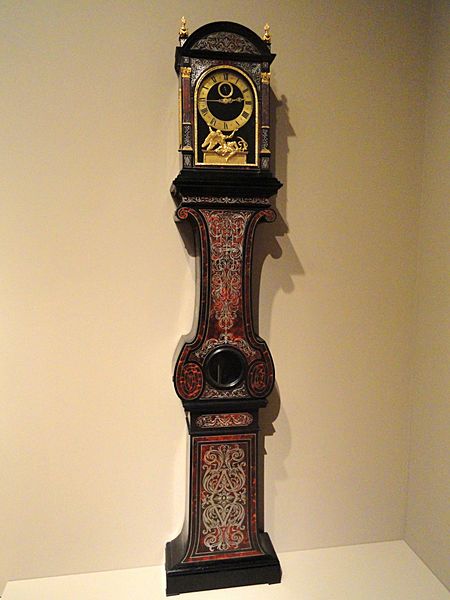
The Wallace Collection
Some of Boulle's most amazing works are in the Large Drawing Room of the Wallace Collection:
The Art Institute of Chicago
-
A casket from the early 18th century, thought to be by Andre-Charles Boulle, at The Art Institute of Chicago.
The Cleveland Museum of Art
-
A cabinet from around 1690, made of ebony, metal, and tortoise shell, by André-Charles Boulle, at the Cleveland Museum of Art.
The Legion of Honor Museum
The Calouste Gulbenkian Museum
The Victoria and Albert Museum
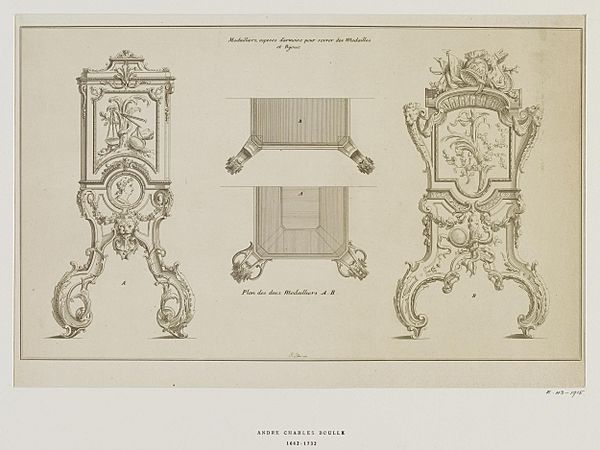
The Paul Getty Museum
Boulle in Châteaux
Château de Vaux Le-Vicomte
Château de Versailles
Grand Trianon
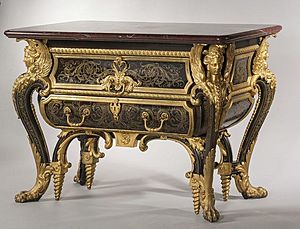
Boulle delivered the first versions of the Mazarin Commode to the Grand Trianon in 1708. The King's building director wrote to Louis XIV, saying the second desk by Boulle was "as beautiful as the other and suits the room perfectly." This design became popular, even though some thought it was a bit awkward because it needed four extra legs to hold the heavy bronze and marble. Boulle's workshop made at least five more of these commodes between 1710 and 1732. One of them is now in the Metropolitan Museum of Art.
Château de Chantilly
Waddesdon Manor
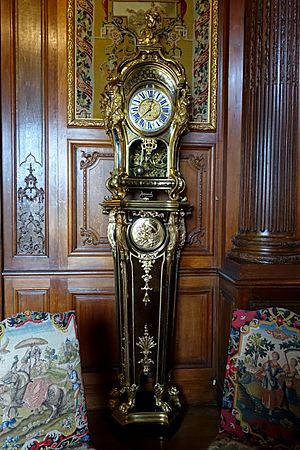
The Royal Collection & Windsor Castle
Most of the furniture in the Royal Collection made by, or thought to be by, Boulle was bought by King George IV (1762–1830). He loved French style and filled the royal palaces with French furniture from the 1780s until his death. The fancy style and use of unique materials fit his lavish taste. However, because many copies were made in the 18th and 19th centuries, and Boulle didn't sign his work, it's hard to say for sure if a piece is truly by him. So, many Boulle-style pieces in the Royal Collection are listed as "attributed to André-Charles Boulle." There are at least 13 works of art by André-Charles Boulle in the Royal Collection, including:
- An Armoire from around 1700 (at Windsor Castle)
- A Cabinet (en première-partie) from around 1700 (at Windsor Castle)
- A Cabinet (en contre-partie) from around 1700 (at Windsor Castle)
- A Cabinet (without a stand)
- A pair of bas d'armoire (low cabinets) (at Windsor Castle)
- A Writing table, possibly made for Louis, the Grand Dauphin (1661–1711), around 1680
- A pair of torchère (tall stands for lights) from around 1700
- A Bureau Plat (flat-topped desk) from around 1710 (at Windsor Castle)
- Small gaines (pedestals), thought to be by him, from the early 18th century. (Source: Royal Collection)
See also
 In Spanish: André-Charles Boulle para niños
In Spanish: André-Charles Boulle para niños
- Barometer Clock (Boulle)
Images for kids




